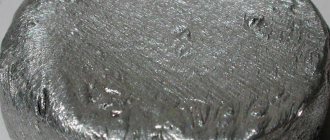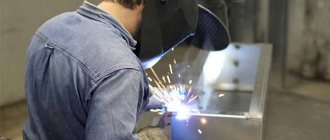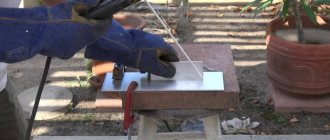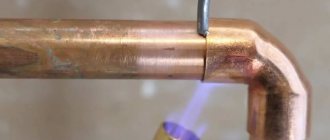Aluminum is a chemical element with strongly pronounced metallic properties. When exposed to oxygen from the surrounding air, it easily oxidizes, forming a dull, gray oxide coating.
This is what aluminum products look like. If the surface is cleaned, a metallic sheen of the pure substance can be observed within a few minutes. A dense, refractory coating of oxides significantly complicates any work with metal.
It is believed that soldering aluminum products is very difficult. This doesn't always happen. A good aluminum solder makes things easier. The composition of the compositions makes it possible to cope with the oxide layer and ensure the formation of a seam.
Why is aluminum difficult to solder?
Many people have tried to solder aluminum at home and understand well: the solder does not want to stick to the surface of the parts. This occurs due to the formation of a stable oxide film on the metal, which has low adhesion to the solder material. Methods for soldering aluminum at home come down to fighting the protective film.
In mineralogy, aluminum oxide is called corundum. It consists of transparent crystals, which are gemstones. Corundum has different colors depending on the impurities: chromium gives a reddish tint, sapphire gives a bluish tint. The oxide film is highly durable and cannot be soldered. It must be removed from the surface and then begin to solder the parts.
Kastolin
Imported castolin consists only of aluminum and zinc. It has good fluidity, penetrating ability, and electrical conductivity.
Some inconvenience is caused by the impossibility of using this solder for parts with a magnesium content of more than 1.5% and products that are subsequently planned to be anodized.
Castolin sells a range of solders with a varied combination of components. After consultation, you can choose a remedy for specific conditions.
How to remove oxide film
The film is removed from the metal surface in several ways, the most effective being chemical and mechanical. Both methods require an airless environment in which there is no oxygen to work.
The chemical method is based on the deposition of zinc or copper on the surface of the workpiece by electrolysis. Copper sulfate in the form of a concentrated solution is applied to the area prepared for soldering. The negative terminal of a battery or other power source is attached to a clean area of metal. One end of the copper wire is connected to the positive terminal, the other is dipped into a solution on the surface of the aluminum. As a result of electrolysis, copper or zinc is deposited in a thin layer on the aluminum and adheres tightly to it. Now you can solder aluminum with tin.
An oil film is used to remove the oxide. For this method, it is better to use synthetic or transformer oil with a low water content. Other types of oils need to be kept at a temperature of +150...+200°C, the water will evaporate. At higher temperatures, the contents will begin to splatter. Dehydrated oil is applied to the surface of the aluminum part. Use sandpaper to rub the aluminum under the applied layer to remove the oxide.
The emery cloth is replaced with a scalpel, a serrated soldering iron tip, or iron filings obtained from a nail rubbed with a file. The shavings are poured onto the oil and the soldering iron tip is rubbed over the surface, removing the oxide layer. It is advisable to heat a massive part with a hot air stream. The solder is dipped into the oil droplet with a soldering iron and rubbed over the soldering area. To improve the soldering process, rosin or other flux is added.
Surface preparation
Before you begin tinning, you must complete the following steps:
- degrease the surface using acetone, gasoline or any other solvent;
- remove the oxide film from the place where soldering will be performed. For cleaning, use sandpaper, an abrasive wheel or a brush with steel wire bristles. As an alternative, etching can be used, but this procedure is not so common due to its specificity.
It should be taken into account that it will not be possible to completely remove the oxide film, since a new formation will immediately appear in the cleaned area. Therefore, stripping is carried out not with the goal of completely removing the film, but to reduce its thickness in order to simplify the task of the flux.
Heating the soldering area
To solder small parts, you can use a soldering iron with a power of at least 100W. Massive items will require a more powerful heating tool.
Soldering iron 300 Watt
The best option for heating is to use a gas burner or blowtorch.
Simple gas burner
When using a burner as a heating tool, the following nuances should be taken into account:
- Do not overheat the base metal, as it may melt. Therefore, it is necessary to regularly monitor the temperature during the process. This can be done by touching the solder to the heated element. Melting the solder will let you know that the required temperature has been reached;
- Oxygen should not be used to enrich the gas mixture, since it promotes strong oxidation of the metal surface.
Fluxes for aluminum soldering
Fluxes are highly active, so after soldering they need to be washed off with a solution of water and alkali. Baking soda works well as an alkali. After the alkali, the joint is washed with clean water. Respiratory organs should be protected from flux vapors entering them. They can irritate mucous membranes and enter the blood. The most common of them need to be considered each separately.
Rosin
Rosin is the most popular of all fluxes. It is used in joining various metals. It works on aluminum only in the absence of air, so it is rarely used. More time is spent when working with rosin, but less efficiency. This flux is not for professionals; it can perform soldering, but the quality of the connection is not strong.
Powder flux
Aluminum is soldered with a gas torch using powder fluxes. It is not recommended to add oxygen to the flame; it reduces the efficiency of the flux. The most common fluxes:
- F-34A;
- borax;
- acetylsalicylic acid;
- solder fat.
F-34A is an active flux containing 50% potassium chloride, 32% lithium chloride, 10% sodium fluoride and 8% zinc chloride. The composition is used with solders containing chemical additives. It is hygroscopic and dissolves in water.
Borax is a powder that melts at 700°C, is soluble in water, and can be washed off with an aqueous solution of citric acid. It is characterized by low cost.
Acetylsalicylic acid is found in the form of aspirin tablets. When heated by a soldering iron, vapors that are harmful to human health are released, burning the nose, eyes and respiratory organs.
Solder fat consists of paraffin, ammonium and zinc chloride, and deionized water. Solders well preheated areas that have undergone tinning procedure. After soldering aluminum parts, it is recommended to wash off the remaining flux, otherwise it will cause corrosion of the metal.
Liquid flux
Liquid flux is applied to the soldering area in a thin layer. When working with a soldering iron, it evaporates quickly, releasing scalding fumes. Flux F-64 contains fluorides, tetraethylammonium, corrosion inhibitors and ionized water. It destroys the oxide film well and helps to solder large aluminum workpieces. Used for soldering copper, aluminum, galvanized iron and other metals.
F-61 consists of triethanolamine, ammonium fluoroborate and zinc fluoroborate. Used for tinning and soldering aluminum alloys at temperatures up to 250°C. Castolin Alutin 51 L consists of cadmium, lead and 32% tin. Works most effectively at temperatures above 160°C.
Materials with tin
There are many metal compositions for soldering aluminum products.
The composition of most low-melting solders is dominated by copper, tin, and lead; cadmium, bismuth, and indium are present.
However, aluminum does not dissolve very well in these metals, which causes reduced strength of the seams formed during soldering.
An additional difficulty is created by the low corrosion resistance of solders made of tin and lead. When working with these compounds, the soldered aluminum joint is coated with paint and varnish protective agents.
Soldering using solders with the following metals gives good results:
- copper;
- zinc;
- aluminum;
- silver;
- silicon.
There are many compositions containing these metals in varying proportions. Domestic craftsmen are primarily interested in Russian products (rods and wire), which have good quality and an affordable price.
A popular solder is 60% tin and 40% zinc. It is known that an increased zinc content gives the weld corrosion resistance.
Solder for soldering aluminum
Solder for soldering aluminum is made from zinc or aluminum. Additives are added to it to achieve various characteristics: to lower the melting point and increase strength. They are produced in America, Germany, France, Russia. Let's look at some of them.
A common and widely advertised solder for aluminum is HTS 2000. It is produced by a company from the USA. Practice shows its fragility: soldered parts allow air and moisture to pass through. It cannot be used without flux.
Castolin 192FBK based on zinc (97%) and aluminum (2%) is produced in France. The Castolin company produces solders 1827 and AluFlam-190, intended for soldering copper and aluminum at 280°C.
Castolin 192FBK is a tubular solder containing flux in the core. It is produced in the form of rods, 100 g of which costs 100-150 rubles. Solders small holes and cracks well.
Chemet Aluminum 13 is a solder used when welding parts at 640°C and above. It is based on aluminum (87%) and silicon (13%). The melting point of solder is about 600°C. It is produced in the form of rods, of which there are 25 pieces per 100 g. 100 g cost 500 rubles. The variety called Chemet Aluminum 13-UF has a hollow structure and contains flux in the core. Its cost for 12 rods, which weigh 100 g, is 700 rubles.
Aluminum solder is also produced at domestic enterprises. For soldering using a gas torch, grade 34A is used. It melts at a temperature of 525°C and solders AMts, AM3M, AMg2 alloys well. 100 g cost 700 rubles.
Grade A consists of 60% zinc, 36% tin and 2% copper. Melts at 425°C. Produced in rods weighing 145 g. The cost of one rod is 400 rubles.
SUPER A+ is produced in Novosibirsk and is an analogue of HTS-2000. Used together with SUPER FA flux. Costs 800 rubles. per 100 g. In the molten state it becomes viscous, you have to use steel tools to level it.
Aluminum soldering torches
You need to know how to solder with a gas torch. If the area of the parts is large and there is not enough soldering iron power, use a torch. It is better to use a gas one, since soldering aluminum with a gas torch has great capabilities. The burner quickly heats the joint of the parts almost to the melting temperature of aluminum. Flux with solder is applied to the joint, leveled with a soldering iron tip and hardened. The joint must be washed to remove any remaining soldering acid or other flux.
When working with burners, you must follow fire safety rules. There should be no flammable liquids or materials nearby.
Process Features
The main features of this type of soldering work are:
- Application of special fluxes and solders;
- Careful preparation of the surfaces to be soldered: cleaning, degreasing, tinning.
- The use of powerful soldering irons and gas burners capable of heating working surfaces to a certain temperature.
Also, during soldering work on parts made of this metal, the heating temperature of the working surfaces is constantly monitored. This is done in order not to overheat the low-melting metal - when heated to a temperature above +250-300 degrees Celsius, the metal structure made from it begins to lose its strength and deform.











